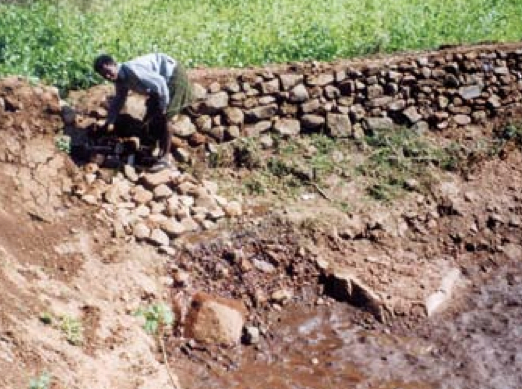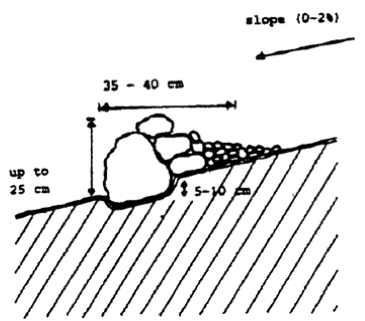Difference between revisions of "Water Portal / Rainwater Harvesting / Groundwater recharge / Bunds"
(→Construction, operations and maintenance) |
(→Construction, operations and maintenance) |
||
| Line 19: | Line 19: | ||
==Construction, operations and maintenance== | ==Construction, operations and maintenance== | ||
| + | [[Image:contourStonebund.JPG|thumb|right|300px| Contour stone bunding on a hillside.]] | ||
| + | [[Image:stonebund.JPG|thumb|right|300px| Details of a stone bund.]] | ||
Local people should have a good degree of control in programme implementation, and the focus should be on appropriate techniques that can be operated and maintained using local resources. However, social/institutional constraints are not the only (or even primary) concern when building bunds – technical considerations are often overlooked. A few lessons learned are listed here which might apply generally: | Local people should have a good degree of control in programme implementation, and the focus should be on appropriate techniques that can be operated and maintained using local resources. However, social/institutional constraints are not the only (or even primary) concern when building bunds – technical considerations are often overlooked. A few lessons learned are listed here which might apply generally: | ||
* The erratic nature of rainfall intensity and lack of good rainfall data meant that designing bunds based on certain assumed runoff coefficients was difficult - sometimes runoff was vastly underestimated, and this was the reason for 90% failure rate of earthworks during the first 2 years of a large bund building programme where high runoff flows damaged bunds. | * The erratic nature of rainfall intensity and lack of good rainfall data meant that designing bunds based on certain assumed runoff coefficients was difficult - sometimes runoff was vastly underestimated, and this was the reason for 90% failure rate of earthworks during the first 2 years of a large bund building programme where high runoff flows damaged bunds. | ||
Revision as of 00:19, 30 March 2012

Bunds (also called teras) are small barriers to runoff coming from external catchments (and possibly to a field where crops are to be grown). Bunds slow down water sheet flow on the ground surface and encourage infiltration (groundwater recharge) and soil moisture. This plot of land is "bunded" on three sides, with the fourth side left open to capture runoff from an elevated area. The bunds consist of small stone or earthen walls constructed along the contour of a plot of land. Bunds also trap sediment and prevent erosion or land degradation. A small channel on the inside of the bunds is made to let the water run along. Excess water drains along the tips of the outer arms. These spillways may improve the efficiency and reduce maintenance costs of the teras. The base bund can be 50-300 meters long, while the arms are usually 20-100 meters long.
Bund design has to be adjusted according to local conditions. They can vary in design and include non-enclosed systems (e.g. trapezoidal bunds where water escapes around the edges), and enclosed systems (e.g. bunded fields where water enters via a channel and escapes from a spillway in the bund once the field is flooded). In certain site-specific examples, they are used to create small artificial glaciers which helps release melt water slowly, so as to adjust to short sowing seasons.
Teras show higher crop returns in dryer years and allow farmers to diversify income sources in normal years. In West Africa the technology is widely used in valley bottoms.
Suitable conditions
- Locate bunds in natural runoff areas, preferably in sites already shaped by topography – indicators include seeing where water flows during flood times, and soil / vegetation types. The key is to approach each site individually and to work with natural topographical features – experience in the area will influence the design.
- Avoid the following areas:
1. Clay areas – bunds made from soil with high clay content develop leaks through pipes in the bund structure which form due to cracks when it dries.
2. Proximity to large water courses.
3. Sites needing extensive levelling.
- Soil in vicinity needs to have sufficient infiltration capacity.
- Ideally the slope should not be greater than 1.5% otherwise earthworks get prohibitive.
- For artificial glaciers, altitude needs to be over 4,600 metres.
- Foothill areas with high intensity and short duration rainfall with between 50 and 400 mm rainfall annually.
- Catchments are typically 2 to 3 times the size of cultivated areas in (semi-) arid regions.
Construction, operations and maintenance
Local people should have a good degree of control in programme implementation, and the focus should be on appropriate techniques that can be operated and maintained using local resources. However, social/institutional constraints are not the only (or even primary) concern when building bunds – technical considerations are often overlooked. A few lessons learned are listed here which might apply generally:
- The erratic nature of rainfall intensity and lack of good rainfall data meant that designing bunds based on certain assumed runoff coefficients was difficult - sometimes runoff was vastly underestimated, and this was the reason for 90% failure rate of earthworks during the first 2 years of a large bund building programme where high runoff flows damaged bunds.
- Undamaged bunds were related to catchment size – smaller catchments that were 4-5 times the size of the cultivated area were not damaged, whereas larger catchments caused bunds to be overtopped due to under-designed spillways. Smaller and more numerous catchments were therefore deemed to be preferable due to the reduced risk associated with them.
- Bund height will vary from site to site, and is related to the slope of land and area to be inundated. The challenge it seems is to size the field/bund area to ensure retention of enough water to carry a crop to maturity from one single flood, without making it susceptible to large unexpected runoff flows – e.g. in Turkana, designing bunds to allow 30cm of flood depth (as confirmed by local knowledge) or in India it meant a flood depth of 15cm.
- Trapezoidal bunds work well in high rainfall intensity areas, and spillways around the edge worked better than spillways in the centre of the bund where erosional forces were concentrated. Even stone-faced spillways (as per Israeli design) were not always robust. Therefore type of bund has to be applicable to the local conditions. The exact shape of the trapezoidal bund varies in shape according to the terrain.
- A few tips for construction of trapezoidal bunds: leveling the cultivated area within a bunded area is a good thing to do since it spreads flood depth evenly; a cut-off drain uphill of the bund allows high flows to be diverted if necessary, protecting the bund; trapezoidal bunds should be reinforced with stonework to counter erosive forces as this is the edge of the spillway in these bunds; low-tech leveling devices help uneducated people to be trained in designing their own bunds.
- Bunds should be adequately compacted. If animals are used to create the bunds, they can help to compact the soil with their hooves. It also seems best to make bunds in the middle of the dry season so that they can settle under impact of human and livestock movement, in order to make them sturdy enough for the rainy season. Access to finance therefore seems to be important in allowing farmers to implement bunds. Due to the uncertain nature of flood events, it is important to plant drought-resistant (local) crop varieties in the fields which give better results.
- In the site-specific case of artificial glaciers, the following methods are used: before the onset of winter, water is channelled from existing streams through 1.5” GI pipes into shadow areas of mountains close to villages. The water is made to flow out onto a sloping hill face where at regular intervals along the mountain slope, small stone embankments are situated to impede the flow of water which helps to create shallow pools. These pools freeze rather than infiltrate, but water is later released for crop irrigation prior to the usual time when snow melts on mountain tops. In this way, water is available more reliably for crops during a very short sowing season.


